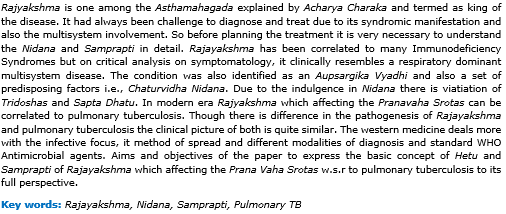Critical understanding of Rajayakshma Samprapti with special reference to Respiratory Dominant Pulmonary Tuberculosis
Keywords:
Rajayakshma, Nidana, Samprapti, Pulmonary TBAbstract
Rajyakshma is one among the Asthamahagada explained by Acharya Charaka and termed as king of the disease. It had always been challenge to diagnose and treat due to its syndromic manifestation and also the multisystem involvement. So before planning the treatment it is very necessary to understand the Nidana and Samprapti in detail. Rajayakshma has been correlated to many Immunodeficiency Syndromes but on critical analysis on symptomatology, it clinically resembles a respiratory dominant multisystem disease. The condition was also identified as an Aupsargika Vyadhi and also a set of predisposing factors i.e., Chaturvidha Nidana. Due to the indulgence in Nidana there is viatiation of Tridoshas and Sapta Dhatu. In modern era Rajyakshma which affecting the Pranavaha Srotas can be correlated to pulmonary tuberculosis. Though there is difference in the pathogenesis of Rajayakshma and pulmonary tuberculosis the clinical picture of both is quite similar. The western medicine deals more with the infective focus, it method of spread and different modalities of diagnosis and standard WHO Antimicrobial agents. Aims and objectives of the paper to express the basic concept of Hetu and Samprapti of Rajayakshma which affecting the Prana Vaha Srotas w.s.r to pulmonary tuberculosis to its full perspective.
Downloads
References
http://www.who.int/mediacentre /factsheets /fs104 /en/index.html.
K. Park Preventive and Social Medicine. Edited by K. Park 20th edition. Jabalpur M/S Banarasidas Bahnot Publishers, 2009.5th chapter; epidemiology of communicable diseases, tuberculosis; 159-176pp
https://en.gaonconnection.com/tuberculosis-india-global-tuberculosis-report2021-world health organisation-covid19- pandemic
Acharya Agnivesha, Charaka Samhita annoted by Caraka and redacted by Dridhabala with the Ayurveda dipika commentary of chakrapani data, edited by vaidya yadavjitrikamji acharya,varanasi, Chaukhamba krishnadas Prakashan 2013, chikitsasthana 8/, pg no-738, pp-43-44.
Bhavmishra : bhavprakasa nigantu (original text along with commentary and translation) edited by Dr bulusu sitaram First edition; 2010, 2nd edition2014, Varanasi, chaukhambha ayurved pratishthan,madhyama khanda,11th chapter shloka no.64-67, pg no-738,191-192pp.
Vagbhata, Astanga Hrudhya, Sarvanaga Sunadri, Commentary of Arunadatta and Ayurveda rasayana Commentary of Hemadri, collected by Dr.Anna Moreswar Kunte and Krisna Ramachandra Shastri Navare, Edited by Bhisanghacharya Harishastri Paradakara Vaidya Varanasi, Chaukhamba Sanskrit Sansthana Prakashan, reprint-2010,chikitsa sthana chapter1/61 pg no-956,pp-555
Agnivesha, Charaka Samhita. Kushavaha Singh Harishchandra editor. Varanasi: Chaukamba Orientalia; reprint 2012.p.459
Sushruta Samhita. Trikamji Jadavji editor. Varanasi: Chaukambha Sanskrit Sansthana; 2010.p.Su.u.711
Sushruta Samhita. Trikamji Jadavji editor. Varanasi: Chaukambha Sanskrit Sansthana; 2010.p.Su.u.
Vaghbata, Ashtang Hridaya, Paratkar Shastri Hari Sadahiv editor. Varanasi: Chaukamba Publication; 2011.p. 472















